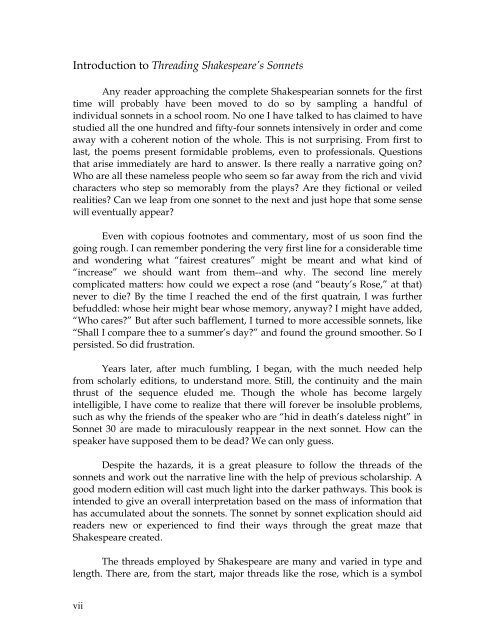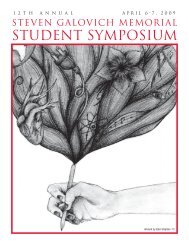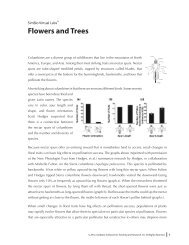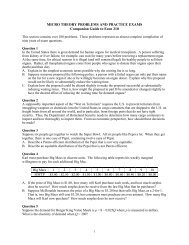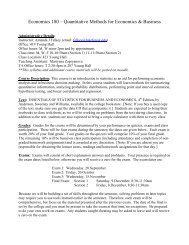Introduction to Threading Shakespeare's Sonnets
Introduction to Threading Shakespeare's Sonnets
Introduction to Threading Shakespeare's Sonnets
You also want an ePaper? Increase the reach of your titles
YUMPU automatically turns print PDFs into web optimized ePapers that Google loves.
is taken when each gives his heart <strong>to</strong> the other. (Sonnet 22) The bliss is short lived.Not only does friction develop, but the agon is complicated by the introduction--at first very briefly--of the triangle involving the mistress, who becomes themistress of each man in turn. (The first stage of this is evident in <strong>Sonnets</strong> 39-42.)The plot proceeds slowly because the speaker is unwilling <strong>to</strong> give up his love forhis friend, the one thing that endures, with difficulty, until the close.Much longer is the third section, which follows the waves of emotion thatbecome more complex as they ebb and flow. As the center of the sequenceapproaches, the speaker sinks in<strong>to</strong> the deepest despondency, imagining his deathand asking his friend not <strong>to</strong> mourn longer than the bell <strong>to</strong>lls. (Sonnet 70) Thoughhe discovers that his love has betrayed him (Sonnet 80) and his poetic powerseems spent, he continues <strong>to</strong> praise his friend and recover from his hatred. Butthe oscillations continue, <strong>to</strong>o, and the speaker reveals his own infidelity. By theend of the section (Sonnet 126), the friend has taken up with others, and theempty spaces at the end of the poem suggest the finality of their relationship.The pathos--typical of the fourth act in a tragedy--begins early and lastslong; the sonnets’ structure is more like that of King Lear, which takes adownward plunge with the rejection of Cordelia at the end of act one. The fourthsection, the sonnets addressed <strong>to</strong> the mistress (127-152), intensify the bitterness ofthe speaker, and cynicism predominates. More swiftly than the sorrows of thespeaker and his friend, the harsher infatuation with the mistress comes <strong>to</strong> griefwhen the speaker loses her utterly <strong>to</strong> the young friend, whom she keeps in thrall.The speaker’s descent in<strong>to</strong> hell, then, is complete when he loses both his lovesand fails <strong>to</strong> find a way out. (Sonnet 144) Ironically he still has doubts, but thereader does not.In the last section, as in a drama’s last act, the speaker/protagonist makesa tragic discovery--this time without a doubt. In Sonnet 152, we learn that thespeaker has found out that the mistress has been unfaithful <strong>to</strong> her husband (shehas broken her “bed-vow”) and, in effect, betrayed at least three men. Thespeaker has gone from one catastrophe <strong>to</strong> another. To cap it all, he reveals that heis himself “forsworn”: he has betrayed himself by swearing her “fair” all along.In <strong>Sonnets</strong> 153 and 154, the catastrophe is rounded out by a finaldiscovery: the speaker has contracted a venereal disease and is seeking a cure inthe sweat baths that were commonly built <strong>to</strong> relieve afflictions like syphilis. ThatShakespeare had such an idea in mind is supported by his frequent mention ofsuch illnesses. One striking parallel in the plays comes in Pandarus’ viciousepilogue <strong>to</strong> Troilus and Cressida:xiv
Long-standing IssuesWhen W. H. Auden declared in 1964 that more nonsense had been writtenabout Shakespeare’s sonnets than any other literary work in the world, hisjudgment was not new. And the mountain of criticism has continued <strong>to</strong> grow;bardolatry is not dead.To get matters in<strong>to</strong> perspective, we need <strong>to</strong> remember that informationabout the sonnets did not begin <strong>to</strong> accumulate until the late eighteenth centurywhen Edmond Malone completed the first scholarly edition, Plays and Poems, in1790. Though Shakespeare probably began writing the sonnets by the mid1590’s-- and there has been much futile dispute about their dates--there was norecorded mention of them until 1598. Then a gentleman of letters, Francis Meres,published a book titled Palladis Tamia, which surveyed literature past andcontemporary. It specially praised Shakespeare, named some of his plays, andcited his “sug’red sonnets among his private friends.” None of the sonnets werepublished until 1599 when two were pirated by the printer William Jaggard for avolume he put <strong>to</strong>gether under the title The Passionate Pilgrim. Jaggard falselyclaimed that all the poems in the book were written by Shakespeare.The complete sonnet sequence did not appear until 1609. This book, thefirst Quar<strong>to</strong>, was made available by Thomas Thorpe, who wrote the crypticdedication which no one has yet deciphered. Far <strong>to</strong>o much time, energy, andpaper has been devoted <strong>to</strong> this problem, so I shall say no more. The actual title ofthe Quar<strong>to</strong> was Shake-speare’s <strong>Sonnets</strong>, a point of interest because no other sonnetsequence was given the author’s name as title. Most sonneteers followed the leadof Sir Philip Sidney’s Astrophel and Stella (1591) by using an invented name, mos<strong>to</strong>ften that of the woman worshipped in the poems. Diana, Cynthia and Delia areexamples of the ladies so honored. The fact that Shakespeare’s sonnets have hisname suggests, but does not prove, that he did not invent the title any more thanhe wrote the dedication. Was the collection compiled by Shakespeare himself?Was it given <strong>to</strong> Thorpe by the author or an intermediary? The chances are weshall never know.What does seem likely is that the sonnets as published were transmittedintact <strong>to</strong> the publisher; although this cannot be proved, the sonnets are nowtreated as if they were a whole presented in the order intended by Shakespeare.In the preceding centuries, the order has been widely disputed and alternateorders have been proposed. Any reader wishing <strong>to</strong> follow this controversyshould begin by consulting Hyder Rollins’ account in the Variorum edition of1944. The text you will be reading has been modernized in keeping with myunderstanding of the work, and as few changes as possible have been madexviii
other than in punctuation, capitalization, and italics. Obvious errors have beensilently corrected. Most importantly, the sonnets are numbered as they are in the1609 Quar<strong>to</strong>. This is universal practice now, but in the second Quar<strong>to</strong> of 1640, thesonnets were re-ordered and the numbers removed by the publisher, JohnBenson, and until Malone’s scholarly edition in the late eighteenth century, hisill-advised changes were influential.The issue of the text is linked <strong>to</strong> the issue of sexuality. No very earlyreactions <strong>to</strong> the sonnets were recorded at all except the brief clause, alreadyquoted, by Francis Meres. Some of the poems copied in private manuscripts havesurvived. However, no significant comments appeared until the second Quar<strong>to</strong>.Like the first publisher, Thomas Thorpe, the second, John Benson, was anentrepreneur primarily interested in making money. At the same time he did notwant <strong>to</strong> alienate an increasingly Puritan society. To that end, he gathered thesonnets, re-arranged them--cutting some up in the process--and shoved them<strong>to</strong>gether <strong>to</strong> disguise the fact that they were fourteen-lines originally. He also gavethem titles of his own devising <strong>to</strong> suggest their morality, and finally wrote apreface which, strangely, described the sonnets as “serene.” Eight of the poemswere omitted and other poems by other poets were mingled with Shakespeare’swithout acknowledgment. His main change, however, was switching male andfemale pronouns <strong>to</strong> conceal the fact that many of the poems were addressed <strong>to</strong> ayoung man.In the eighteenth century, sonnets were out of fashion and ignored. Dr.Johnson did not think them worth criticizing. He edited Shakespeare’s plays, buthe did not deign <strong>to</strong> do the same for the sonnets. Though he admired the plays hedid not think them great sources of moral instruction, and one suspects that hethought the same about the sonnets. He simply didn’t comment. It was the sameJohnson who <strong>to</strong>ld Boswell that all s<strong>to</strong>ries ought <strong>to</strong> be true. With the Romantics,the sonnet was res<strong>to</strong>red, but the taint of what the Vic<strong>to</strong>rians considered sexualimmorality still clung <strong>to</strong> Shakespeare, who was cheerfully bowdlerized. By theend of the nineteenth century, however, opinions began <strong>to</strong> change becausebardolatry had taken over. Though Oscar Wilde was scarcely the most popularadvocate of the sonnets, he was influential, and The Portrait of Mr. W. H. (1889), afanciful picture of a boy-ac<strong>to</strong>r in Shakespeare’s plays, gave further impetus <strong>to</strong> thesearch for the identity of the friend in the sonnets. Readers of all sorts hadalready begun <strong>to</strong> look for the “true” s<strong>to</strong>ry behind them. What would Dr. Johnsonhave said?In the twentieth century, and now in our own, sexuality in the sonnetsbecame a primary matter of interest, and the arguments and theories havesomewhat clouded over the poetry. It cannot be denied that homosexuality andhomoeroticism are words that came in<strong>to</strong> being in the nineteenth century and thatxix


